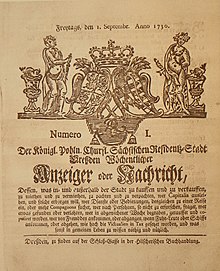Dresdner Anzeiger
The Dresdner Anzeiger is probably the oldest, in any case the longest (1730–1945) existing daily newspaper in Dresden .
The intellectual author is the council auctioneer Johann Christian Crell , who on March 30, 1730, applied to the King and Elector August the Strong to give him the privilege of a weekly advertising paper , a “question and answer sheet”. The background to this was that Crell wrote handwritten messages as the first periodical publications in Dresden from 1714 onwards.
Even before a decision was made, the bookseller and pastor's son Gottlob Christian Hilscher (1705–1748) had also made a request to the King and Elector on August 20, 1730, and was given the privilege at short notice. On September 1, 1730, he published the newspaper Der Königl, initially twice a week . Pohln. Elector Sächsische Residentz-Stadt Dreßden Weekly Anzeiger or message , in the meantime Dresdner Advertisements , later called Dresdner Anzeiger for short , which was ostensibly an advertising journal, but - according to the first edition - also reported "what else in common life is necessary and useful to know" . The tradition of the “intelligence slip”, which originated around 1720, was thus integrated into the sheet. Crell, the actual idea generator, worked for a while (which gradually made the "Anzeiger" an information and announcement organ of the Dresden Council). The Anzeiger was sold by the Hilscher bookstore on Schloßstraße .
After Hilscher's death, the privilege granted went to various booksellers until Baroness von Schlichten inherited it in 1829. The managing power of attorney granted to the father in 1829 went to his son in 1834: Justus Friedrich Güntz . The latter finally acquired the Dresdner Anzeiger in 1837 , of which he became the sole editor in 1839. Now the Dresdner Anzeiger finally became the official gazette of the city of Dresden.
Due to a few strokes of fate, Güntz founded a private foundation under public law, the Güntz Foundation , to which he brought the privilege of publishing the Dresden Gazette and whose earnings fed the foundation.
After several changes of seat, the Dresdner Anzeiger was published from 1900 onwards from the seat in Breite Straße . In 1943, the Nazi authorities forcibly merged it with the Dresdner Neuesten Nachrichten to form the Dresdner Zeitung ; after the air raids on Dresden from February 13 to 15, 1945, it ceased publication. In 1951 the Güntz Foundation was also declared dissolved.
literature
- Entry: Dresdner Anzeiger , in Folke Stimmel et al .: Stadtlexikon Dresden A – Z , Verlag der Kunst, Dresden 1994, ISBN 3-364-00300-9 , p. 107.
Web links
- Dresdner Anzeiger in the Stadtwiki Dresden
Individual evidence
- ^ Hermann Heckmann: Sachsen , Historische Landeskunde Mitteldeutschlands, Stiftung Mitteldeutscher Kulturrat (ed.), Verlag Weidlich, 1985, ISBN 3-8035-1259-X , page 208, excerpt from google.books.de, accessed on March 30, 2020.
- ↑ a b Gabriela B. Christmann: Dresden's splendor, the pride of Dresdeners . Deutscher Universitäts-Verlag, Wiesbaden 2004, ISBN 3-8244-4560-3 . P. 166, digitized
- ↑ Klaus Brendler: City council, editor of the »Dresdner Anzeiger« and patron ( Memento from February 3, 2016 in the Internet Archive ) on eliasfriedhof-dresden.de
- ↑ Justus Friedrich Güntz ( Memento from April 12, 2016 in the Internet Archive ) on a flyer from the Dresden Community Foundation
